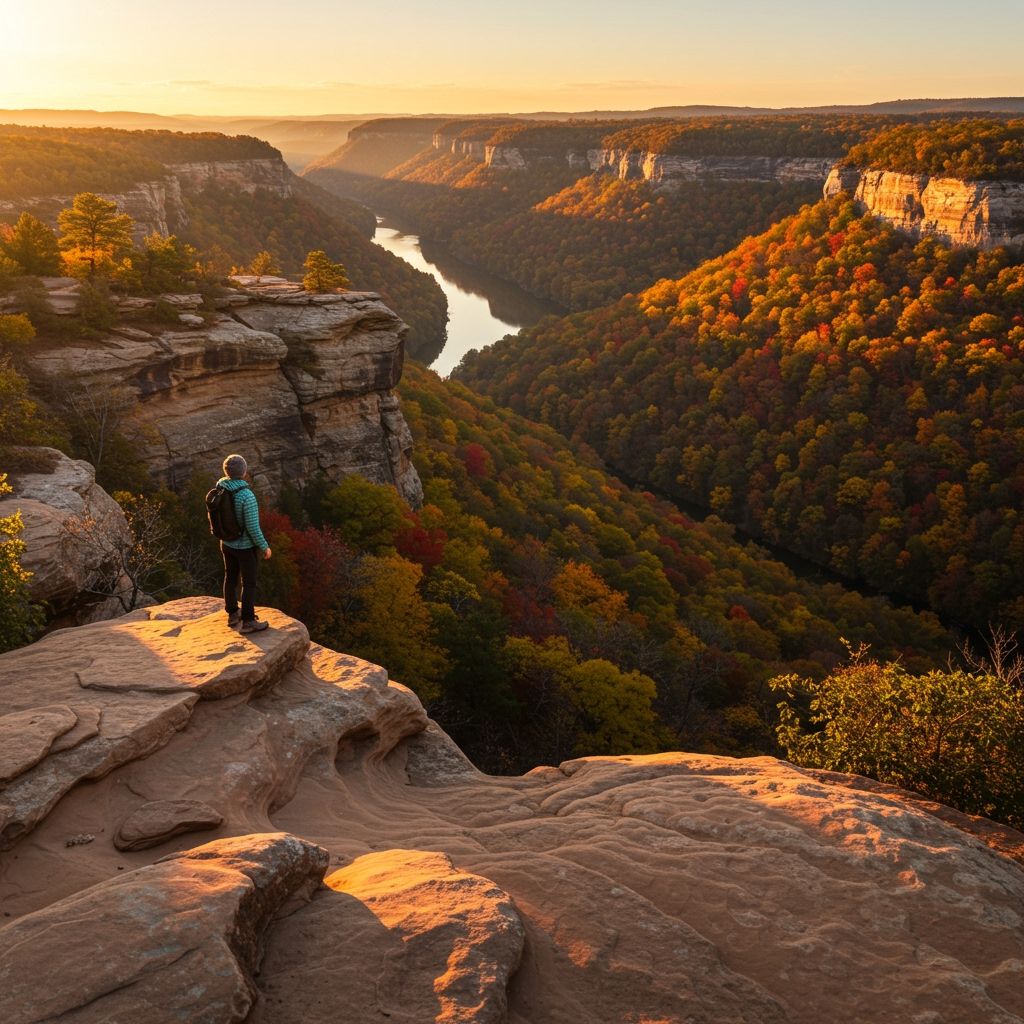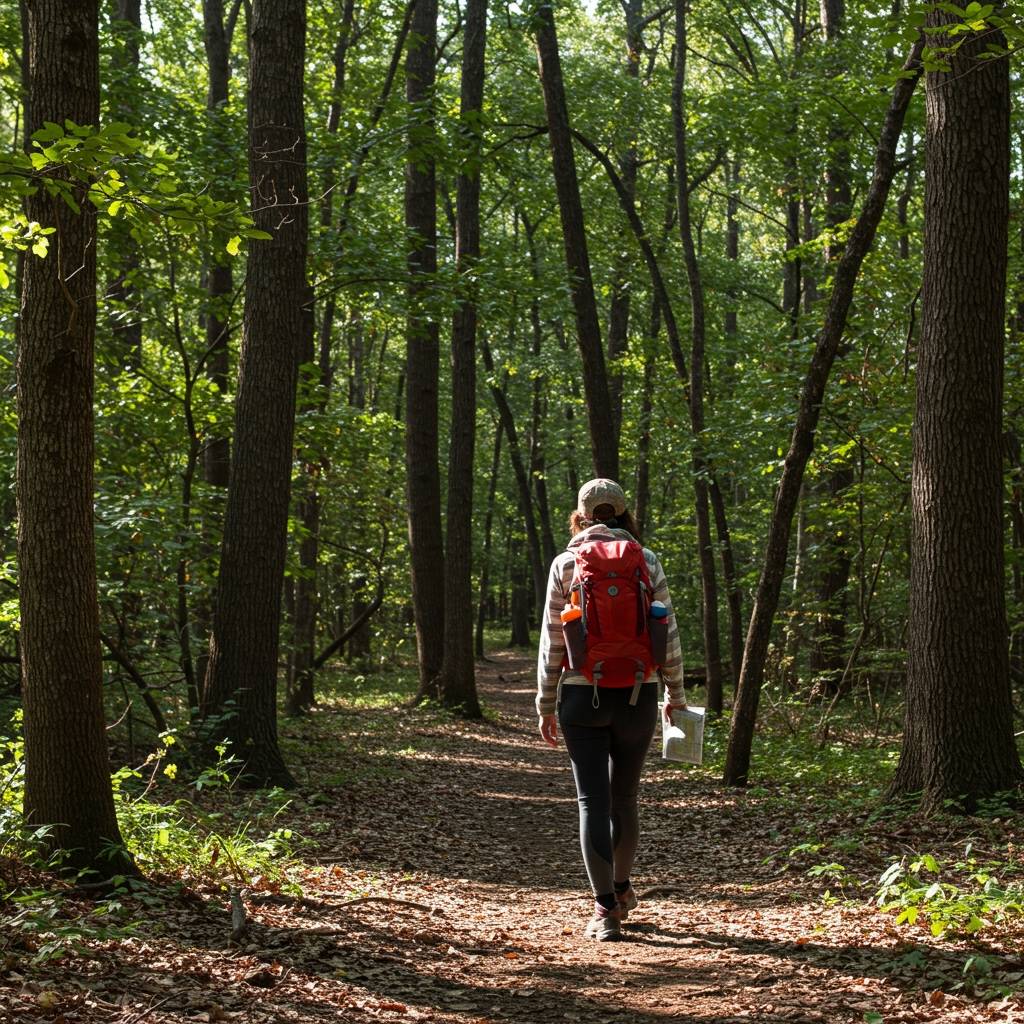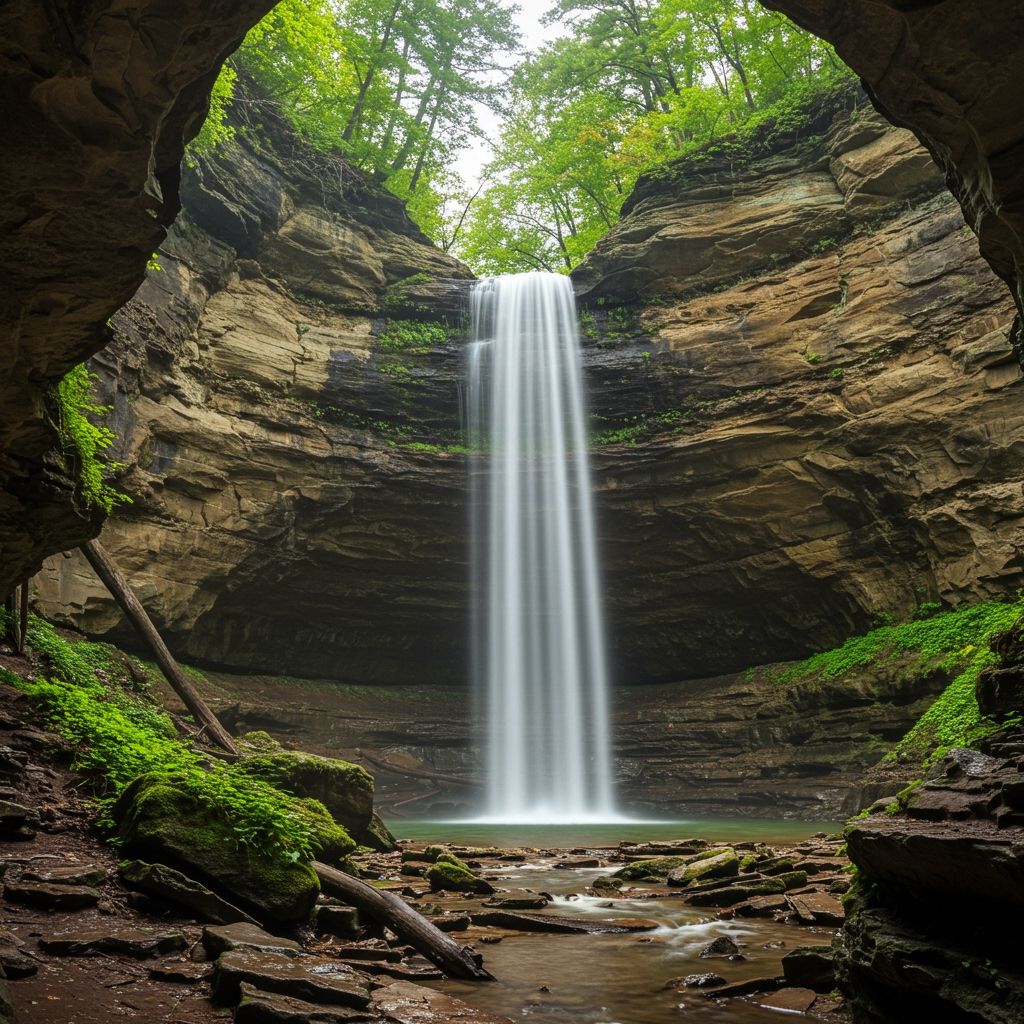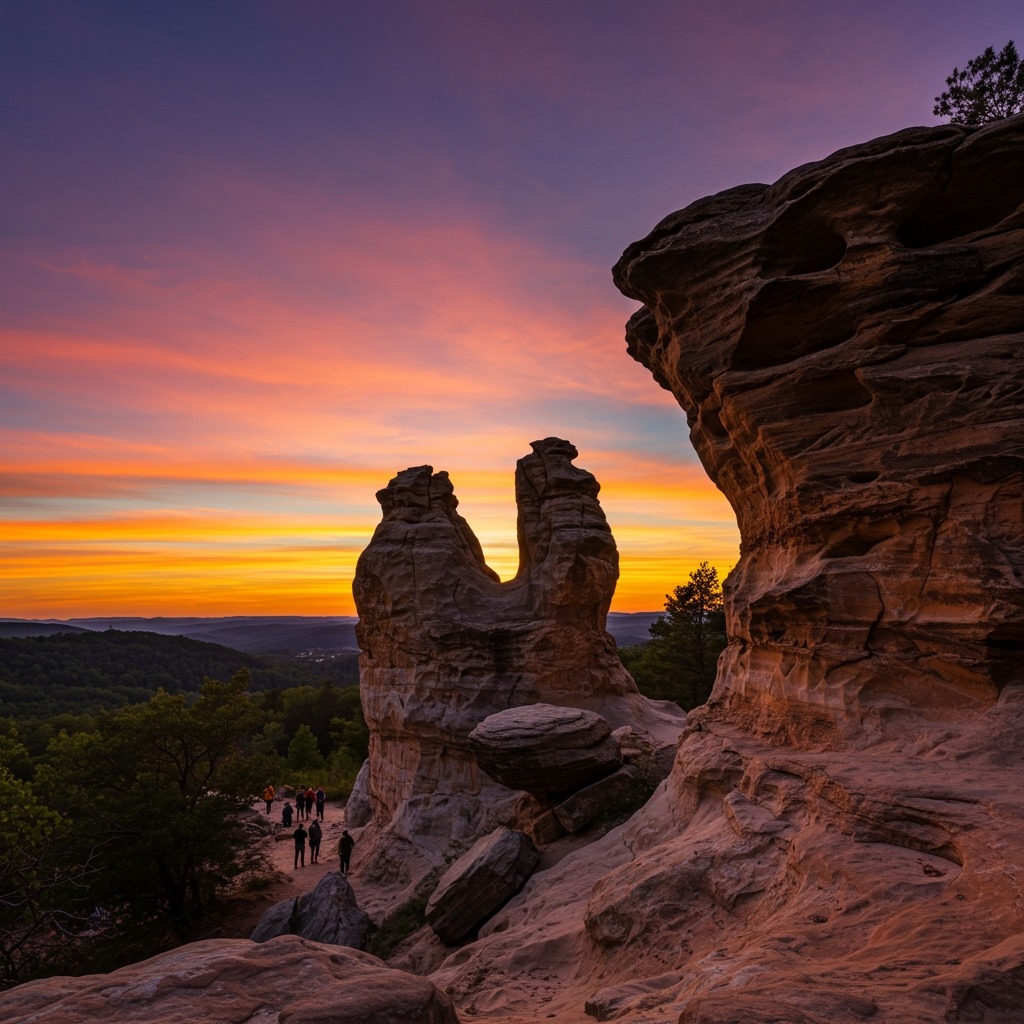Think Illinois is just endless stretches of flat cornfields and cityscapes? Prepare to be surprised. Beyond the well-trodden paths of urban life lies a diverse and captivating world for trail lovers. Are you ready to discover dramatic canyons, ancient forests, and serene lakeside paths, all within the Prairie State? Your adventure hiking in Illinois starts now, and it promises landscapes that will challenge your perceptions and invigorate your spirit.
Illinois might not be the first state that springs to mind for rugged expeditions, but that’s precisely where its hidden charm lies. This is a place where you can find unexpected geological wonders, from the sandstone bluffs of Starved Rock to the otherworldly formations in the Shawnee National Forest. It’s a land teeming with biodiversity, where prairies burst with wildflowers, dense woodlands offer shady retreats, and wetlands provide sanctuary for countless species. Many trails also whisper tales of the past, winding through areas rich in Native American history and the echoes of early settlers. Perhaps best of all, hiking in Illinois offers something for everyone, with a vast network of trails catering to all skill levels, from leisurely family strolls to genuinely challenging backcountry treks.

Gearing Up for Your Illinois Trail Adventure
Before you hit the trails, a little preparation goes a long way in ensuring a safe and enjoyable experience. Illinois’ varied terrain and changeable weather demand some thought in your packing.
- Footwear is Key: Don’t underestimate the terrain. Sturdy, comfortable hiking shoes or boots with good traction are essential, especially for trails that can be rocky, muddy, or involve elevation changes.
- Dress in Layers: Illinois weather can shift, even within a single day. Opt for moisture-wicking base layers, an insulating middle layer, and a waterproof and windproof outer shell. This allows you to adapt as conditions change.
- Navigate Like a Pro: While many trails are well-marked, always carry a map. Park-specific maps are often available at visitor centers or online. Apps like AllTrails can also be invaluable for navigation and discovering new routes.
- Fuel Your Hike: Bring plenty of water, especially on warmer days or longer hikes. Pack energy-boosting snacks like trail mix, fruit, or energy bars to keep you going.
- Seasonal Essentials: During warmer months, insect repellent is a must to ward off mosquitoes and ticks. Sunscreen and a wide-brimmed hat will protect you from the sun, even on cloudy days.
- Practice Leave No Trace: Help keep Illinois beautiful by adhering to the Leave No Trace principles. This means packing out everything you pack in, staying on marked trails, and minimizing your impact on the environment.
Discover Illinois’ Premier Hiking Regions & Unforgettable Trails
Ready to explore? Illinois is geographically diverse, offering distinct hiking experiences from north to south.
Northern Illinois: Canyons, Bluffs & Lakeside Vistas
The northern reaches of the state are home to some of Illinois’ most iconic and dramatic landscapes.
- Starved Rock State Park (Utica):
- The Lowdown: This is arguably Illinois’ most famous hiking destination, and for good reason. It boasts 18 stunning canyons, seasonal waterfalls that cascade after rains, and breathtaking overlooks of the Illinois River.
- Must-Hike Trails:
- French Canyon: An easily accessible and beautiful canyon, perfect for a shorter hike (0.4 miles from the visitor center).
- LaSalle Canyon & St. Louis Canyon: Known for their picturesque waterfalls and scenic beauty.
- Canyon Loop (various options): Combine several trails for a more challenging and comprehensive exploration of the park’s highlights. (Approx. 4.7 miles for a popular loop).
- Pro-Tips: Starved Rock is incredibly popular. Visit on weekdays or during the off-season to avoid the biggest crowds. Always check the Illinois Department of Natural Resources (DNR) website for trail conditions and potential closures, especially after heavy rain, as some areas can become slippery or inaccessible.
- Matthiessen State Park (Utica):
- The Lowdown: Just a stone’s throw from Starved Rock, Matthiessen offers a similarly spectacular landscape of canyons (known as dells) and waterfalls but often with fewer people.
- Must-Hike Trails:
- Dells Area Trail (approx. 5 miles): Explores both the upper and lower dells, leading to the impressive 45-foot Cascade Falls. Prepare for stairs!
- Lake Falls: Another beautiful waterfall feature within the park.
- Why It’s Worth It: Discover unique geological formations and enjoy a more secluded experience compared to its bustling neighbor.
- Adeline Jay Geo-Karis Illinois Beach State Park (Zion):
- The Lowdown: Experience a different kind of hiking in Illinois with unique coastal trails along the shores of Lake Michigan. This park protects the last remaining stretch of natural shoreline in the state.
- Trails to Wander: Explore miles of sandy shores, walk among towering dunes, and traverse nature trails that wind through diverse ecosystems including marshes and oak forests.
- Don’t Miss: It’s a haven for birdwatchers and home to many rare plant species.
- Waterfall Glen Forest Preserve (Darien, near Chicago):
- The Lowdown: A fantastic day-trip option from Chicago, offering surprisingly diverse landscapes. You’ll find prairies, savanna, lush oak-maple woodlands, and the impressive tiered Rocky Glen waterfall.
- Trail Options:
- Main Loop (approx. 9-11 miles): A crushed limestone trail popular with hikers, bikers, and runners, encircling the Argonne National Laboratory.
- Poverty Prairie Trail (approx. 2 miles): Showcases the preserve’s beautifully restored grasslands.
- Perfect For: Those seeking a substantial hike with varied scenery without venturing too far from the city.
- Rock Cut State Park (Loves Park):
- The Lowdown: As the largest state park in Northern Illinois, Rock Cut offers a wealth of outdoor activities centered around the beautiful Pierce Lake.
- Hiking Highlights: Numerous trails wind through forests and around the lake, offering opportunities for spotting wildlife.
- More Than Hiking: Enjoy paddling, fishing, and camping in this expansive natural oasis.

Central Illinois: Prairies, Forests & River Valleys
Central Illinois showcases the state’s namesake prairies alongside rolling woodlands and tranquil river systems.
- Allerton Park & Retreat Center (Monticello):
- The Lowdown: A unique destination where art meets nature. This estate, part of the University of Illinois, features formal gardens, striking sculptures, and over 14 miles of hiking trails through natural woodlands and along the Sangamon River.
- Trails to Explore: Wander through diverse settings, from meticulously manicured gardens to wilder forest paths.
- Unique Charm: The blend of natural beauty with artistic and architectural elements like the Fu Dog Garden and the 1900s mansion makes for a memorable hike.
- Kickapoo State Recreation Area (Oakwood):
- The Lowdown: Once a surface mining operation, nature has impressively reclaimed this area, creating a landscape of deep-water ponds (popular for kayaking and fishing) and lush forests.
- Trail Focus:
- Out and Back Trail (approx. 7.6 miles): Offers a challenging hike through the reclaimed land.
- Shorter, less demanding walks are also available for a more casual exploration.
- Forest Glen Preserve (Westville):
- The Lowdown: If you think Illinois is entirely flat, this preserve will swiftly change your mind. It features rugged terrain along the Vermilion River, with deep ravines and old-growth forests.
- Signature Experience: The 11-mile Backpacking Trail offers a true wilderness feel, with challenging climbs and rewarding views, perfect for an overnight trip.
- Hennepin Canal Parkway State Trail:
- The Lowdown: One of Illinois’ premier long-distance trails, the Hennepin Canal stretches for 155 miles (including the feeder canal).
- What to Expect: This mostly flat trail follows the historic canal, offering a peaceful journey through Illinois’ agricultural heartland, interspersed with woodlands and wetlands. Great for extended hikes or bike rides.
Southern Illinois: The Mighty Shawnee National Forest & Beyond
Southern Illinois is a world apart, dominated by the rugged beauty of the Shawnee National Forest and other geological wonders. This is where you’ll find some of the most challenging and rewarding hiking in Illinois.
- Shawnee National Forest Overview:
- This sprawling forest covers approximately 289,000 acres between the Mississippi and Ohio Rivers. It’s a vast expanse of oak-hickory forests, sandstone cliffs, unique geological formations, and wilderness areas.
- It’s a prime destination for serious hikers, backpackers, and nature lovers seeking solitude and adventure.
- Garden of the Gods Recreation Area (Shawnee NF, near Herod):
- The Lowdown: Perhaps the most photographed location in the Shawnee, Garden of the Gods features breathtaking 320-million-year-old sandstone formations.
- Key Trail: The Observation Trail is a relatively easy 0.25-mile loop on a stone path that offers stunning panoramic views of the surrounding wilderness and iconic formations like Camel Rock (featured on an Illinois quarter!). Longer, more rugged trails connect through the wider wilderness area.
- Insider Tip: Due to its popularity, visit early in the morning or on weekdays to best enjoy the serenity.
- Little Grand Canyon Trail (Shawnee NF, near Murphysboro):
- The Lowdown: This 3.4-mile loop trail offers a truly adventurous hike. It descends steeply into a deep canyon, follows a creek bed (prepare for some rock scrambling and potential wet feet!), and then climbs back out, rewarding hikers with views of the Big Muddy River floodplain.
- Be Prepared: This trail is considered moderately challenging to difficult due to steep ascents/descents and uneven terrain. It can be particularly treacherous when wet.
- Rim Rock National Recreation Trail / Pounds Hollow (Shawnee NF, near Elizabethtown):
- The Lowdown: Rim Rock features an upper trail that is partially paved and follows the remnants of a prehistoric Native American stone wall. The lower trail descends via stairs into a lush canyon with impressive rock overhangs, one of which is said to have been a stop on the Underground Railroad.
- Nearby: Pounds Hollow Lake offers swimming, boating, and additional hiking opportunities.
- Ferne Clyffe State Park (near Goreville):
- The Lowdown: Nestled just outside the main Shawnee NF boundaries, Ferne Clyffe is known for its stunning waterfalls (especially after rains), lush fern-filled canyons, and unique rock formations like Hawks’ Cave (a massive shelter bluff).
- Trail Highlights:
- Waterfall Trail (1 mile loop): A beautiful and relatively easy hike to a picturesque waterfall.
- Happy Hollow Trail (approx. 5 miles): A more challenging route that explores deeper into the park’s forests and past scenic creeks and a natural arch.
- Giant City State Park (Makanda, near Carbondale):
- The Lowdown: Famous for its massive sandstone structures, eroded over millennia to create “streets” fit for giants.
- Popular Trails:
- Giant City Nature Trail: An easy, short loop that winds through the impressive stone “streets.”
- Red Cedar Hiking Trail (approx. 12 miles): A rugged and challenging backpacking trail for experienced hikers. (The IL DNR sometimes promotes a “Red Cedar Challenge”).
- Bonus: The park also offers rock climbing and rappelling in designated areas, and the historic Giant City Lodge is a great place for a post-hike meal.
- Cache River State Natural Area (near Belknap):
- The Lowdown: Step into a different world in this unique wetland complex, featuring ancient cypress-tupelo swamps that feel more like the Deep South than Illinois.
- Must-Do: The Heron Pond Trail includes a floating boardwalk that takes you right through the heart of the cypress swamp – an unforgettable experience.
- Wildlife Haven: This area is a critical stopover for migratory birds and home to diverse wildlife. Excellent for birding and photography.
- Tunnel Hill State Trail (Vienna to Karnak and beyond):
- The Lowdown: This 45-mile (with spurs extending further) crushed-stone rail-trail is perfect for long-distance hiking and biking.
- Highlights: The trail passes through diverse scenery, including forests, wetlands, small towns, and its namesake – a 543-foot long tunnel that you get to walk or ride through.

Hiking in Illinois: A Year-Round Pursuit
One of the great things about hiking in Illinois is that it can be enjoyed throughout the year, with each season offering its own unique charm.
- Spring: Witness the landscape awaken. Wildflowers carpet forest floors, and waterfalls, like those at Starved Rock and Ferne Clyffe, are often at their most impressive due to spring rains.
- Summer: Enjoy lush green canopies and long daylight hours. However, be prepared for heat, humidity, and insects. Early morning or late evening hikes are often most comfortable.
- Fall: Perhaps the most popular hiking season, autumn brings cooler temperatures and a spectacular display of fall foliage, especially in places like Shawnee National Forest and Pere Marquette State Park (known for its vibrant colors along the Mississippi River).
- Winter: Experience the quiet serenity of snow-covered trails. This season is also prime time for eagle watching along the major rivers, with spots like Starved Rock and Mississippi Palisades State Park offering excellent viewing opportunities. Be aware that some trails may be icy or have seasonal closures.
Trail Safety & Etiquette: Hike Responsibly
To ensure a safe and enjoyable experience for yourself and to protect Illinois’ natural beauty for others, please keep these points in mind:
- Stay on Marked Trails: This protects fragile ecosystems and prevents you from getting lost. Many parks, like Starved Rock and Matthiessen, emphasize this due to dangerous cliffs and canyons.
- Be Aware of Wildlife: Illinois is home to deer, coyotes, snakes (mostly non-venomous, but be cautious), and ticks. Know how to react and take precautions against ticks, especially in wooded and grassy areas.
- Check Park Alerts: Before you go, visit the specific park’s website (often the IL DNR site) for any trail closures, advisories on conditions, or information about hunting seasons which might affect trail access or require you to wear bright colors.
- Leash Your Pets: Where dogs are allowed, they must generally be kept on a leash no longer than 6 feet and under your control at all times. Always check specific park regulations.
- Respect Private Property: Some trails may border or cross private land. Please respect these boundaries.

Beyond the Hike: Make a Trip of It
Extend your hiking in Illinois adventure by exploring nearby attractions:
- Charming Lodges & Cabins: Many state parks, like Starved Rock Lodge and Giant City Lodge, offer comfortable accommodations right in the heart of nature.
- Quaint Local Towns: Discover the charm of small towns near popular hiking areas, such as Utica near Starved Rock or the various small communities dotting Southern Illinois, which often have local diners, antique shops, and friendly faces.
- Visitor Centers & Outfitters: Park visitor centers are excellent resources for maps, trail advice, and local knowledge. Local outfitters can provide gear or guided experiences in some areas.
Read more: Best Hiking Trails Near Nashville: Top Parks & Waterfalls
Your Illinois Hiking Adventure Awaits
Illinois offers a surprisingly rich and varied tapestry of hiking experiences, far beyond any preconceived notions of a flat, featureless state. From the dramatic canyons of the north to the ancient forests of the south, trails are waiting to be explored. So, lace up your boots, pick a trail that calls to you, and discover the unexpected beauty of hiking in Illinois. You might just find your new favorite path.
FAQ: Hiking in Illinois
Q1: Is hiking in Illinois actually challenging?
Absolutely! While there are plenty of easy, family-friendly trails, locations like the Shawnee National Forest (e.g., Little Grand Canyon, parts of the River to River Trail), challenging climbs at Forest Glen Preserve, and some of the longer, more rugged trails in Starved Rock State Park offer genuinely strenuous hikes that will test your endurance.
Q2: When is the best time to see waterfalls in Illinois?
Spring (typically March-May) is often the best time, as melting snow and spring rains feed the waterfalls, making them more voluminous and dramatic. Waterfalls can also be impressive after any period of heavy rainfall throughout the year.
Q3: Are dogs allowed on Illinois hiking trails?
Generally, yes, dogs are allowed in most Illinois State Parks and on many trails, provided they are kept on a leash of no more than 6 feet and are under control. However, rules can vary by specific park or natural area (e.g., some nature preserves might have restrictions). Always check the specific park’s regulations before you go.
Q4: What’s the longest hiking trail in Illinois?
The River to River Trail in Southern Illinois is one of the longest, spanning approximately 160 miles across the Shawnee National Forest from the Mississippi River to the Ohio River. The Hennepin Canal Parkway State Trail is also very long, offering about 155 miles of trail (including the feeder canal).
Q5: Do I need a permit for hiking in Illinois?
For general day hiking in Illinois State Parks and most other public lands, you typically do not need a permit. However, permits may be required for backcountry camping/backpacking in certain areas (like some parts of the Shawnee National Forest), for group activities, or for special events. It’s always a good idea to check with the managing agency of the specific area you plan to visit.
Q6: Where can I find the best views for hiking in Illinois?
Some of the most acclaimed views can be found at:
Garden of the Gods Observation Trail (Shawnee NF): Sweeping vistas of unique sandstone formations.
Starved Rock State Park: Overlooks like Eagle Cliff or Lover’s Leap provide stunning views of the Illinois River and canyons.
Little Grand Canyon rim (Shawnee NF): Dramatic views into the canyon and over the Big Muddy River floodplain.
Mississippi Palisades State Park: High bluffs overlooking the Mississippi River.
Pere Marquette State Park: Scenic overlooks of the Illinois and Mississippi Rivers confluence.
